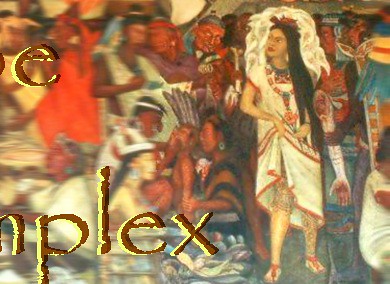Conservative Junta (1858-1863)
The 1850's were a period of extremely complicated upheaval and constitutional crisis. The Roman Catholic Church was extremely powerful and aligned with the haciendas (large estates). In the urban areas, small merchants and civil servants tended to favor a strong national government, which could challenge the clergy and landlords. Dithering between the Liberals and Conservatives took on a different character when the US invaded Mexico in April 1846. The Mexican-American War was a debacle for the Conservatives, whose ideological petulance doomed the efforts of Liberals to defend the country. Making matters worse, the disaster led to a new dictatorship by hyper-Conservative Antonio López de Santa Anna.
In 1854, Santa Ana's rule was so severely discredited that even Conservatives colluded in his ouster. They then consented to a new constitutional convention, which completed its deliberations in February '57. The new constitution included many of the rights guaranteed by the US Bill of Rights, as well as many far-sighted progressive reforms such as the abolition of capital punishment and sharp restrictions on the powers of the Church. Structurally, the constitution also greatly weakened the presidency relative to congress.
Then-president Ignacio Comonfort accepted the constitution, but was confronted with a Conservative mutiny. The Conservatives issued a manifesto, the Plan de Tacuyuba, which Comonfort accepted--effectively retaking power he had earlier agreed to sign away. His president of the supreme court, Benito Juárez, denounced this illegal act and was imprisoned for his pains.
This was naturally unacceptable to the Conservatives, who demanded Comonfort resign anyway. Comonfort held out for ten days, abrogated his abrogation of the constitution, and released Juárez. In a few hours Juárez was promoted from prisoner to designed president. Comonfort and Juárez then went their separate ways.
Military realities compelled the legitimate president of the nation, Juárez, to flee to Guanajuato. The leader of the Conservatives was Brig. General Félix María Zuloaga, who would naturally rule the country during the first year of the civil war he launched. The acts of the Conservative Junta during the Reform War were picaresque: for example, on 23 January 1859, the Junta had three presidents (all acting). In a very rare discrepancy, Wikipedia and World Statesmen do not concur on the dates of terms. Miguel Miramón had a running feud with Zuloaga over control of the home office, with the 28-year old "president" at one point having his 57 year-old rival hauled off to jail.
On 1 January 1861, Juárez and the Liberals returned to Mexico City as victors. Miramón fled to Europe. Juárez was declared president by congress and attempted to restore the ruined finances by nationalizing Catholic institutions. The Conservative militia effectively ran the countryside and assassinated Liberal parliamentarians; the victorious Liberal government's writ did not extend very far, despite peace agreements. As the Conservatives prodded, Zuloaga again declared himself president, proposing to resume the civil war. Lacking the power to collect taxes, the Liberals suspended payments. This caused the European powers to now prepare for an invasion of Mexico. In April, the US Civil War began. Six months later, the major European powers invaded as well, while the Mexican congress debated impeaching Juárez (they declined by one vote).
The Conservative Junta survived in the form of deadender Zuloaga, who attempted to collaborate with the French after they established the "Supreme Provisional Executive Power." This was a regime intended to pave the way for a European dynastic transplant into Mexico, much as had been done in Romania, Bulgaria, and Greece earlier in the decade. The SPEP was a non-entity that relieved on Conservative support for French rule of the country. It was dissolved about a month after Maximilian von Habsburg took power as emperor of Mexico.
List of Presidents of Mexico, 1855-1911
_____________________________________________________
ADDITIONAL SOURCES & READING: Wikipedia entry, Ignacio Comonfort, Félix María Zuloaga Trillo, 1857 Constitution of Mexico, Reform War (1857-1861);
In 1854, Santa Ana's rule was so severely discredited that even Conservatives colluded in his ouster. They then consented to a new constitutional convention, which completed its deliberations in February '57. The new constitution included many of the rights guaranteed by the US Bill of Rights, as well as many far-sighted progressive reforms such as the abolition of capital punishment and sharp restrictions on the powers of the Church. Structurally, the constitution also greatly weakened the presidency relative to congress.
Then-president Ignacio Comonfort accepted the constitution, but was confronted with a Conservative mutiny. The Conservatives issued a manifesto, the Plan de Tacuyuba, which Comonfort accepted--effectively retaking power he had earlier agreed to sign away. His president of the supreme court, Benito Juárez, denounced this illegal act and was imprisoned for his pains.
This was naturally unacceptable to the Conservatives, who demanded Comonfort resign anyway. Comonfort held out for ten days, abrogated his abrogation of the constitution, and released Juárez. In a few hours Juárez was promoted from prisoner to designed president. Comonfort and Juárez then went their separate ways.
Military realities compelled the legitimate president of the nation, Juárez, to flee to Guanajuato. The leader of the Conservatives was Brig. General Félix María Zuloaga, who would naturally rule the country during the first year of the civil war he launched. The acts of the Conservative Junta during the Reform War were picaresque: for example, on 23 January 1859, the Junta had three presidents (all acting). In a very rare discrepancy, Wikipedia and World Statesmen do not concur on the dates of terms. Miguel Miramón had a running feud with Zuloaga over control of the home office, with the 28-year old "president" at one point having his 57 year-old rival hauled off to jail.
On 1 January 1861, Juárez and the Liberals returned to Mexico City as victors. Miramón fled to Europe. Juárez was declared president by congress and attempted to restore the ruined finances by nationalizing Catholic institutions. The Conservative militia effectively ran the countryside and assassinated Liberal parliamentarians; the victorious Liberal government's writ did not extend very far, despite peace agreements. As the Conservatives prodded, Zuloaga again declared himself president, proposing to resume the civil war. Lacking the power to collect taxes, the Liberals suspended payments. This caused the European powers to now prepare for an invasion of Mexico. In April, the US Civil War began. Six months later, the major European powers invaded as well, while the Mexican congress debated impeaching Juárez (they declined by one vote).
The Conservative Junta survived in the form of deadender Zuloaga, who attempted to collaborate with the French after they established the "Supreme Provisional Executive Power." This was a regime intended to pave the way for a European dynastic transplant into Mexico, much as had been done in Romania, Bulgaria, and Greece earlier in the decade. The SPEP was a non-entity that relieved on Conservative support for French rule of the country. It was dissolved about a month after Maximilian von Habsburg took power as emperor of Mexico.
List of Presidents of Mexico, 1855-1911
_____________________________________________________
ADDITIONAL SOURCES & READING: Wikipedia entry, Ignacio Comonfort, Félix María Zuloaga Trillo, 1857 Constitution of Mexico, Reform War (1857-1861);



0 Comments:
Post a Comment
<< Home